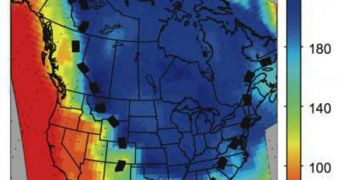A team of geologists has recently determined that the North American tectonic plate is not made up of a single, solid piece, but of several layers, which alternate new and old rocks.
The finding could have important consequences for the field of tectonic studies, which are used to predict the risk an area has of experiencing earthquakes and volcanic activity.
The physics involved in the case of a massive slab of solid rock floating on an ocean of molten rock are entirely different than the calculations needed to explain how a sandwich of rocky layers to the same thing.
According to the new research, it would appear that the North American tectonic plate is similar to a layer cake, featuring a section that contains rock about 3 billion years old.
This layer sits atop a much newer one, reveals a series of investigations conducted deep underneath the continent. It could be that the new data will be able to explain how our planet developed its continents.
From this point of view, Earth is unique in the solar system, as the only body where active tectonic processes can still be found to this day.
“This is exciting because it is still a mystery how continents grow,” explains University of California in Berkeley (UCB) researcher Barbara Romanowicz.
She is also a member of the team that conducted the recent investigation, and the director of the Seismological Laboratory at the university.
“We think that most of the North American continent was constructed in the Archean (eon) in several episodes, perhaps as long ago as 3 billion years, though now, with the present regime of plate tectonics, not much new continent is being formed,” Romanowicz adds.
“I think our paper will stimulate people to look more carefully at distinguishing the ages of the lithosphere as a function of depth,” the expert adds, quoted by OurAmazingPlanet.
Details of the new work were published in the August 26 issue of the top-rated scientific journal Nature.
“Any information we can provide that constrains models of continental formation is really useful to the geodynamicists,” Romanowicz concludes.
Further analysis into this peculiarity could reveal for example that the same boundaries exist at other locations around the world, although at this point, these are only speculations. h

 14 DAY TRIAL //
14 DAY TRIAL //